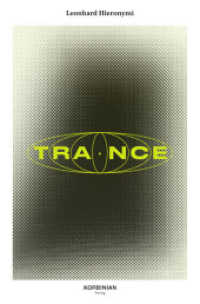Full Description
A team of researchers from 35 states across the country developed a survey designed to create a snapshot of social studies teaching and learning in the United States. With over 12,000 responses, it is the largest survey of social studies teachers in over three decades. We asked teachers about their curricular goals, their methods of instruction, their use of technology, and the way they address the needs of English language learners and students with disabilities. We gathered demographic data too, along with inquiries about the teachers' training, their professional development experiences, and even whether they serve as coaches.
The enormous data set from this project was analyzed by multiple research teams, each with its own chapter. This volume would be a valuable resource for any professor, doctoral student, or Master's student examining the field of social studies education.
It is hard to imagine a research study, topical article, or professional development session concerning social studies that would not quote findings from this book about the current status of social studies. With chapters on such key issues as the teaching of history, how teachers address religion, social studies teachers' use of technology, and how teachers adapt their instruction for students with disabilities or for English language learners, the book's content will immediately be relevant and useful.
Contents
Part I. Foundations.
Chapter 1. The Evolution of a National Survey of Social Studies Teachers, Nancy C. Patterson and Jeff Passe.
Chapter 2. Survey on the Status of Social Studies (S4): An Instrumentation Description, Paul G. Fitchett and Phillip J. VanFossen.
Chapter 3. From the Field: What Social Studies Teachers in Three States Report They Do in the Classroom, Gayle Y. Theimann, Joseph E. O'Brien, Patrice Preston-Grimes, John P. Broome, and Thomas W. Barker.
Part II. Types of Schools.
Chapter 4. Early Childhood Social Studies: A National Study of Challenges and Promising Practices, Ilene R. Berson and Steven Camicia.
Chapter 5. Elementary Social Studies: An Examination in Practice, Matthew Schertz and Theresa M. McCormick.
Chapter 6. Not Too Hot, Not Too Cold: Social Studies in Today's Middle Schools, Gary Homana and Jeff Passe.
Chapter 7. Moving Toward More Dynamic Instruction: A Comparison of How Social Studies Is Taught Among Disciplines and Advanced Placement Courses, Ryan Knowles and Rebecca Theobald.
Part III. Curricular Emphases.
Chapter 8. Social Studies and Democratic Values, Donna K. Pearson and Robert A. Waterson.
Chapter 9. Enlightenment or Getting Burned: A National Survey of Social Studies Teachers' Emphasis on Diversity of Religious Views, James M. M. Hartwick, Jeffrey M. Hawkins, and Mark P. Schroeder.
Chapter 10. The Teaching of Race and Class in American Social Studies Classrooms, Ellen Bigler, Jessica T. Shiller, and Lara Willox.
Chapter 11. K-12 History Education: Curriculum, Instruction, and Professional Development, Anne-Lise Halvorsen.
Chapter 12. National Study on the State of Social Studies Teachers Survey: Perspectives on Geography Teachers, Rebecca Theobald, Seth Dixon, Audrey Mohan, and Zachary Moore.
Chapter 13. Social Studies Educators and the Factors of Race and Ethnicity in the Differential Exercise of Classroom Authority, Peter Hlebowitsh, Gregory E. Hamot, Hyeri Hong, and Karl R. Leitz.
Part IV. Teaching Strategies.
Chapter 14. A Time Machine to the Past: Using Primary Sources in the Social Studies Classroom, Sarah Jewett and Ann T. Ackerman.
Chapter 15. Use of Technology, Gayle Y. Thieman, Joseph E. O'Brien, Phillip J. VanFossen, and Michael J. Berson.
Chapter 16. Finding One's Place in the World: Current Events in the K-12 Social Studies Classroom, George Lipscomb and Frans Doppen.
Chapter 17. Those Who Do: Social Studies Teachers' Use of Role Play and Simulations and the Making of 21st Century Citizens, Jason M. Stephens, Joseph R. Feinberg, and John Zack.
Chapter 18. How Are Teachers of Social Studies Addressing the Needs of English Language Learners in Their Classrooms? Margarita Jimenez-Silva, Elizabeth Hinde, and Norma Jimenez Hernandez.
Part V. Professional Issues.
Chapter 19. Who Is at the Gate? An Examination of Secondary Social Studies Teacher Support and Curricular Control in Testing and Non-Testing States, Nancy C. Patterson, Sherri L. Horner, Prentice Chandler, and Robert Dahlgren.
Chapter 20. Teachers Want Technology and Content, with More Time to Study: Professional Development Issues from the Social Studies Teacher Survey, Rebecca Theobald and Jean Luckowski.
Part VI. What It All Means.
Chapter 21. The Status of Social Studies and the Common Core State Standards: An Opportunity for Reform, John K. Lee.
Chapter 22. Postscript: The Status of Social Studies, Margaret S. Crocco.
Chapter 23. Children of a Lesser God: An Idiosyncratic Interpretation of Social Studies Status, William B. Stanley.
About the Editors.
Appendix: Survey on the Status of Social Studies (S4).







